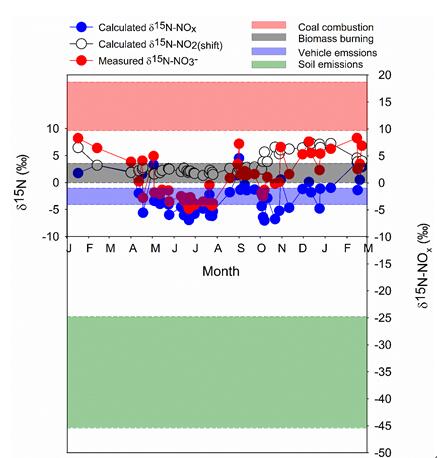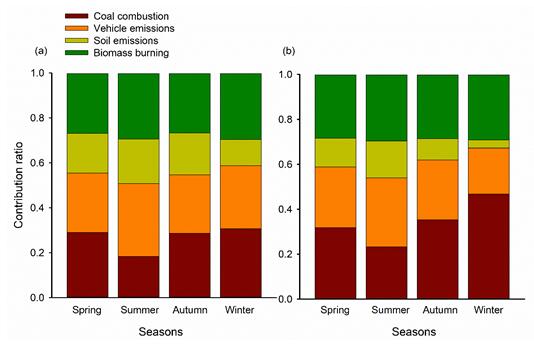Atmospheric nitrate (NO3-), a sink of nitric oxides (NOx), is an important nitrogen supply to terrestrial and marine ecosystems through wet and dry deposition. Excess deposited nitrogen can cause series of negative impacts on ecosystems, such as soil acidification, eutrophication of water and so on.
Due to the fast development of economy, NOx emissions keep increasing in China, resulting in continuous increase in nitrogen deposition. To regulate the NOx emissions and reduce nitrogen deposition, it is crutial to understand the contributions of different emission sources. Previous studies have shown that 15N natural abundance is a useful tool to explore the contribution of emission sources to atmospheric nitrate.
However, accurately quantifying the contributions remains difficult due to the fractionation effects in atmospheric formation processes of nitrate.
To study the seasonal pattern of the 15N natural abundance (expressed as δ15N) in atmospheric NO3- and to determine its dominant factors, Prof. FANG Yunting and his colleagues from the Institute of Applied Ecology (IAE), the Chinese Academy of Sciences (CAS), collected precipitation in 2016 and 2017 from Shenyang city in northeastern China and measured the δ15N of NO3-.
Specifically, They explored if the 15N fractionation effects in the oxidation of NO to NO2 (NOx cycling) was important and affected the seasonal pattern ofδ15N of nitrate in precipitation.
The researchers, reported that the amount of inorganic N deposition at Shenyang was 19.8 kg N ha-1 a-1, of which 53% was in the form of NO3-. Significant seasonal difference of N deposition was found, with higher in summer and lower in winter. The mean value of δ15N-NO3- was 0.9±4.0‰, fluctuating from -4.9 to +8.3‰ (Figure 1). Significant seasonal difference was also found in δ15N-NO3-, with lower in summer and higher in winter (Figure 1). The fractionation effects in NOx cycling was found to be minimal probably due to the complete transformation of NO to NO2 by oxidants (O3, HO2/RO2), whereas source emission change (i.e. coal combustion) is the dominant factor affecting the seasonal variation of Shenyang precipitation NO3- (Figure 2). Fossil fuel combustion (coal combustion and vehicle emissions) contributes 54-67% to Shenyang atmospheric NOx (Figure 2).
The research was financially supported by the National Key R&D Program of China, the Key Research Program of Frontier Sciences of Chinese Academy of Sciences, the National Natural Science Foundation of, National Research Program for Key Issues in Air Pollution Control and K.C.Wong Education Foundation.
The study entitiled” Nitrate isotopic composition in precipitation at a Chinese megacity: Seasonal variations, atmospheric processes and implications for sources”, has been published in Earth and Space Science.

Figure 1. Seasonal changes of measured δ15N-NO3-, calculated fractionation δ15N-NO2(shift) and corrected δ15N-NOx for fractionation. Different colors of shade indicate the range of δ15N-NOx calculated by mean δ15N-NOx ± SD from literature (Image by LI Zhengjie).

Figure 2. The contributions of each NOx source to precipitation NO3- in Shenyang in four different seasons, calculated with (a) and without (b) considering isotope fractionation (Image by LI Zhengjie).
Email: yueqian@iae.ac.cn
Publication Name: LI Zhengjie et al.